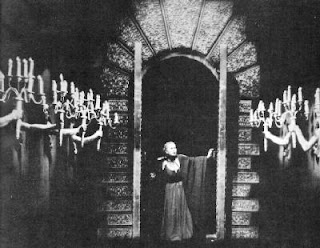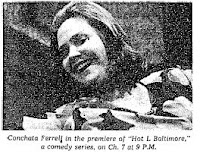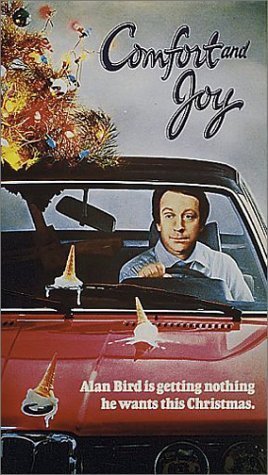(1987)
Directed and Written by Elaine May
Starring Warren Beatty, Dustin Hoffman, Isabel Adjani, Charles Grodin
IMDB Entry
If there ever was a movie with an undeserved reputation, it is Ishtar. You've heard of it — the worst comedy ever made. A mention of the name gets laughs. The movie is supposed to be one big unfunny mess.
Only it isn't.
 Now, I'm not saying Ishtar is a great movie. But it is, overall, a good one. And parts of it achieve great comedy. It's certainly funnier than anything Adam Sandler has ever done (OK, faint praise, but still . . . )
Now, I'm not saying Ishtar is a great movie. But it is, overall, a good one. And parts of it achieve great comedy. It's certainly funnier than anything Adam Sandler has ever done (OK, faint praise, but still . . . )
There was one big problem with Ishtar: its price tag. It cost around $40 million to produce. While nowadays, that's peanuts for a film (Sandler's The Longest Yard cost over twice that), it was expensive back in 1987: one of the most expensive films up to that point.
That $40 million figure poisoned the well. Critics back then, remembering Heaven's Gate, figured that any film spending that much money had to be trash. Even worse, there was no sign of the money on the screen. So the knives came out.
A few critics bucked the trend (I remember that Newsday on Long Island ignored the expense and gave it a good review, and Vincent Canby of the Times -- one of the top film critics of the day -- mentioned it as just missing out on his ten-best list). But others went into the theater expecting trash (some even bragged about it), Every single review did mention the price tag, which is interesting, but hardly relevant to whether the film was good or not.
So the film tanked. Self-fulfilling prophecy and all that. And it has developed a reputation for the ages that is totally unjustified on all counts.
The movie is often compared to the Hope/Crosby "Road" pictures. It is indeed similar, but also much different. The Road pictures were pretty much plotless meanderings —Hope and Crosby get in trouble, with Dorothy Lamour in the middle. Hope wisecracks; Crosby sings and gets Lamour. But the Road pictures were filled with "anything for a joke" lines, self-referential humor, and topical references. Ishtar had none of these. In their place, it had characters. Hope and Crosby always were Hope and Crosby. Warren Beatty and Dustin Hoffman were Lyle Rogers and Chuck Clark.
The plot involves two talentless singer/songwriters who go to the mythical Arabian country of Ishtar, supposedly to give a concert. They get involved in a plot to overthrow the government involving a missing sacred map, and a CIA agent (the delightful Charles Grodin) who tries to use them to find the map and keep the government in power. A mysterious woman (played by Isabelle Adjani) is involved keeping the mix moving.
The first twenty minutes of the film is pure comic brilliance. I can see why a critic coming in with a chip on his shoulder would dismiss it: it's a very dry, wry comedy of character. Rogers and Clark's career is shown in flashback. They have no talent, of course. And it's all excruciatingly funny.
It's helped by Paul Williams's brilliant songs. Their tunes are catchy but unmemorable, but it's the lyrics that make them such gems:
Telling the truth can be dangerous business.
Honest and popular don't go hand in hand.
If you admit that you can play the accordion,
No one'll hire you in a rock 'n' roll band.
(Elaine May and Dustin Hoffman also joined in. A full list can be found at Richard Muller's Ishtar Lyrics website.)
The genius of the movie is that Rogers and Clark never really understand just how awful they are (except in a few flashes). The have no conception that a song "I'm leaving some love in my will" might be inappropriate for an elderly couple. They come up with really awful lyrics and start praising them as though they were the greatest things since Cole Porter ("When you're on, you're on" is one of the funnier lines -- said after a particularly bad lyric). It's one of the few portrayals of the mindset of someone who is working his damndest to be artistic, but who just doesn't have the chops.
The flashback ends with Rogers and Clark deciding to go to Ishtar for the gig.
When they reach it, the comedy does flag. Adjani tries to recruit them both to find the map; Grodin tells Hoffman that she's a communist. Hoffman is indignant that Beatty didn't tell him that Adjani asked him to be a communist. There's a tedious bit about men with sunglasses all trying to shadow Hoffman and Beatty and trying to keep their movements secret from both the two men and the other spies.
Then Hoffman and Beatty go into the market, supposedly to make contact with an agent. The password is to ask to buy a blind camel, and when they call the name of their contact (Muhammad), everyone answers to it (unsurprisingly). This is where things pick up.
Hoffman and Beatty end up in the desert with the blind camel, with no food and little water. There are some good gags, leading to one of the funniest scenes in film: the arms auction.
Hoffman is captured by arms traders; Beatty escapes by donning Arab garb. Hoffman tries to pass himself off as the translator to the native tribes they dealers are selling to. Of course, a man who speaks English but not Arabic is immediately suspect, and Hoffman, at the risk of his life, is supposed to show his ability by telling the tribesman that their camels have been stolen. Hands at his sides, he screams out gibberish.
But Beatty, disguised among the tribesman, begins to gesture and run to the camels; the others follow. Hoffman's story is believed.
The rest of the scene is also very funny. It is a real high point of any film.
Alas, after that, things fall apart. The ending seems rushed, and doesn't really pay off properly. It's OK, but it feels like May was very much under the gun to get things done, so patched together something that is just adequate.
But I don't find it disappointing. The more I see the first section, the funnier it seems. The humor is completely deadpan (which is why people missed it), but, if you pay attention, it's right on the mark.
The saddest thing about the flop is what it did to Elaine May. She had made three previous films: A New Leaf, The Heartbreak Kid, and Mickey and Nicky. The Heartbreak Kid, in particular, is comic gold. The story of a newlywed (Grodin again) who falls in love with Cybell Shepard -- on his honeymoon (with Jeannie Berlin, May's daughter and the part May probably would have played if she were younger at the time). It's based on a Bruce Jay Friedman story (Friedman was a wonderfully warped writer) with a script by Neil Simon, and it's hilarious. Watch it and never think of Key Lime Pie the same way again.
Where was I? Oh, yes. After Ishtar, May never directed another film. That is a tremendous loss of a great comic talent.
So, if you have a chance, watch the movie. You'll be pleasantly surprised.
(To learn more about Ishtar, visit the fan site at Ishtar: The movie.)







 Alfred Hitchcock is one of my favorite film directors. It's hard to say that any of his films are actuallyforgotten (other than Bon Voyage and Adventure Malgache, two short films that only recently became available), or even overlooked, but one particular gem that seems to take the back seat inSaboteur.
Alfred Hitchcock is one of my favorite film directors. It's hard to say that any of his films are actuallyforgotten (other than Bon Voyage and Adventure Malgache, two short films that only recently became available), or even overlooked, but one particular gem that seems to take the back seat inSaboteur.  The film has some great setpieces. I especially liked the way Kane freed himself from handcuffs -- and the logical result of how he did it. There was also a nice suspenseful scene at a party when Kane tries to tell the guests that Tobin is a spy. There's Kane and Pat being picked up by a circus train. The saboteur's look when he passes the wreck of the Normanidie. And, of course, the final sequence at the Statue of Liberty (a dress rehearsal for the Mt. Rushmore scene in North by Northwest).
The film has some great setpieces. I especially liked the way Kane freed himself from handcuffs -- and the logical result of how he did it. There was also a nice suspenseful scene at a party when Kane tries to tell the guests that Tobin is a spy. There's Kane and Pat being picked up by a circus train. The saboteur's look when he passes the wreck of the Normanidie. And, of course, the final sequence at the Statue of Liberty (a dress rehearsal for the Mt. Rushmore scene in North by Northwest).  (1957)
(1957) Peter Sellers is the best-known member of the cast. Here he plays Mr. Quill, the old projectionist and the only one who know how to keep the antiquated Rube Goldberg projector running. No mugging, but a performance that is both funny and charming. The movie is sometimes marketed as though Sellers is the star, but I doubt anyone would be disappointed.
Peter Sellers is the best-known member of the cast. Here he plays Mr. Quill, the old projectionist and the only one who know how to keep the antiquated Rube Goldberg projector running. No mugging, but a performance that is both funny and charming. The movie is sometimes marketed as though Sellers is the star, but I doubt anyone would be disappointed. 
 The plot is an old one, dating in films back at least to the 1920s: the ventriloquist whose dummy takes on a life of its own. Corky Withers (Anthony Hopkins), a failed magician, becomes a success on stage once he switches to ventriloquism. His dummy, Fats, is nasty and cruel, but a big success.
The plot is an old one, dating in films back at least to the 1920s: the ventriloquist whose dummy takes on a life of its own. Corky Withers (Anthony Hopkins), a failed magician, becomes a success on stage once he switches to ventriloquism. His dummy, Fats, is nasty and cruel, but a big success.  You really can't get more forgotten than this. It's a TV show that’s barely listed in the IMDB* and without an entry in Wikipedia (as of this writing), and it's only mentioned in passing on the web. It took me two days of searching before I could find an episode list online (Since taken down). But it was one of the high points of TV, even if few people saw it. "Off the beaten path" indeed.
You really can't get more forgotten than this. It's a TV show that’s barely listed in the IMDB* and without an entry in Wikipedia (as of this writing), and it's only mentioned in passing on the web. It took me two days of searching before I could find an episode list online (Since taken down). But it was one of the high points of TV, even if few people saw it. "Off the beaten path" indeed.  Not everything was commissioned by NBC; several episodes were the first American showing of BBC programmes. The Beatles were shown rehearsing "Hey, Jude" as a part of a show on music in Britain, hosted by Alistair Cooke (before he became connected with PBS). The Pinter show -- short animations scripted by him, with a look at to how they were made -- starred several big British stars, and the Stoppard play, The Engagement, was made in the UK, probably for the BBC (and got theatrical release), but was shown in the US first.
Not everything was commissioned by NBC; several episodes were the first American showing of BBC programmes. The Beatles were shown rehearsing "Hey, Jude" as a part of a show on music in Britain, hosted by Alistair Cooke (before he became connected with PBS). The Pinter show -- short animations scripted by him, with a look at to how they were made -- starred several big British stars, and the Stoppard play, The Engagement, was made in the UK, probably for the BBC (and got theatrical release), but was shown in the US first.  (2005)
(2005) The fly in the ointment is Joe's brother, Leo (Thomas Gomez), a small time bookie who doesn't want to fall in with the big time crooks. Joe has to convince Leo before July 4, and Leo -- an honest bookie who will pay everything he owes, even if it ruins him -- refuses.
The fly in the ointment is Joe's brother, Leo (Thomas Gomez), a small time bookie who doesn't want to fall in with the big time crooks. Joe has to convince Leo before July 4, and Leo -- an honest bookie who will pay everything he owes, even if it ruins him -- refuses. 
 (1972)
(1972) Now, I'm not saying Ishtar is a great movie. But it is, overall, a good one. And parts of it achieve great comedy. It's certainly funnier than anything Adam Sandler has ever done (OK, faint praise, but still . . . )
Now, I'm not saying Ishtar is a great movie. But it is, overall, a good one. And parts of it achieve great comedy. It's certainly funnier than anything Adam Sandler has ever done (OK, faint praise, but still . . . ) 
 VR.5 was a show ahead of its time. This doomed it to failure.
VR.5 was a show ahead of its time. This doomed it to failure.  (1984)
(1984) (2005)
(2005) It's not uncommon to look at TV shows and ask "What are they thinking?" Usually, it's when a particularly stupid concept somehow makes it to the air. After all, network executive tend to err on the side of stupidity. But, every once in awhile, you ask yourself this even though the show is of high quality. NBC had a history of showing things that were good, but which you could never understand why they'd expect good ratings from it (for instance, Dame Edna and Spitting Image).
It's not uncommon to look at TV shows and ask "What are they thinking?" Usually, it's when a particularly stupid concept somehow makes it to the air. After all, network executive tend to err on the side of stupidity. But, every once in awhile, you ask yourself this even though the show is of high quality. NBC had a history of showing things that were good, but which you could never understand why they'd expect good ratings from it (for instance, Dame Edna and Spitting Image).  (1932)
(1932) Scarface is the story of Tony Camonte (Muni) who, like Tom Powers and Little Caesar, is a brutal, small-time crook who works his way up to be crime boss. Muni is abetted by his pal Guino Rinaldo (George Raft) and his sister Francesca, who is Guino's girlfriend. The most interesting bit is the relationship between Tony and Francesca, which shows them as more than just brother and sister. The hints of incest were quite daring for the time.
Scarface is the story of Tony Camonte (Muni) who, like Tom Powers and Little Caesar, is a brutal, small-time crook who works his way up to be crime boss. Muni is abetted by his pal Guino Rinaldo (George Raft) and his sister Francesca, who is Guino's girlfriend. The most interesting bit is the relationship between Tony and Francesca, which shows them as more than just brother and sister. The hints of incest were quite daring for the time. 

 (199-93)
(199-93) But there's a problem. Harlan Stone (a combination of Harlan Ellison and Frank Miller), is the new writer of the strip, and wants to darknight Mad Dog into the brooding, moody, haunted superhero who was the new style in the 90s. "We can unleash the beast and reveal the true Mad Dog-a tortured, maniacal vigilante!'' Stone exclaims. Bob wanted Mad Dog to be an older model -- truth, justice, that sort of thing. (Marvel Comics actually did a series of Mad Dog comics to tie in with the show.)
But there's a problem. Harlan Stone (a combination of Harlan Ellison and Frank Miller), is the new writer of the strip, and wants to darknight Mad Dog into the brooding, moody, haunted superhero who was the new style in the 90s. "We can unleash the beast and reveal the true Mad Dog-a tortured, maniacal vigilante!'' Stone exclaims. Bob wanted Mad Dog to be an older model -- truth, justice, that sort of thing. (Marvel Comics actually did a series of Mad Dog comics to tie in with the show.) It's rare that you pick up an unheralded book and realize it is truly great. Even heralded books are hard to find. In the science fiction/fantasy field, there were things like Dune, Replay, The Book of the New Sun, and Lord of the Rings. Lately, that feeling has happened to me less and less often.
It's rare that you pick up an unheralded book and realize it is truly great. Even heralded books are hard to find. In the science fiction/fantasy field, there were things like Dune, Replay, The Book of the New Sun, and Lord of the Rings. Lately, that feeling has happened to me less and less often.